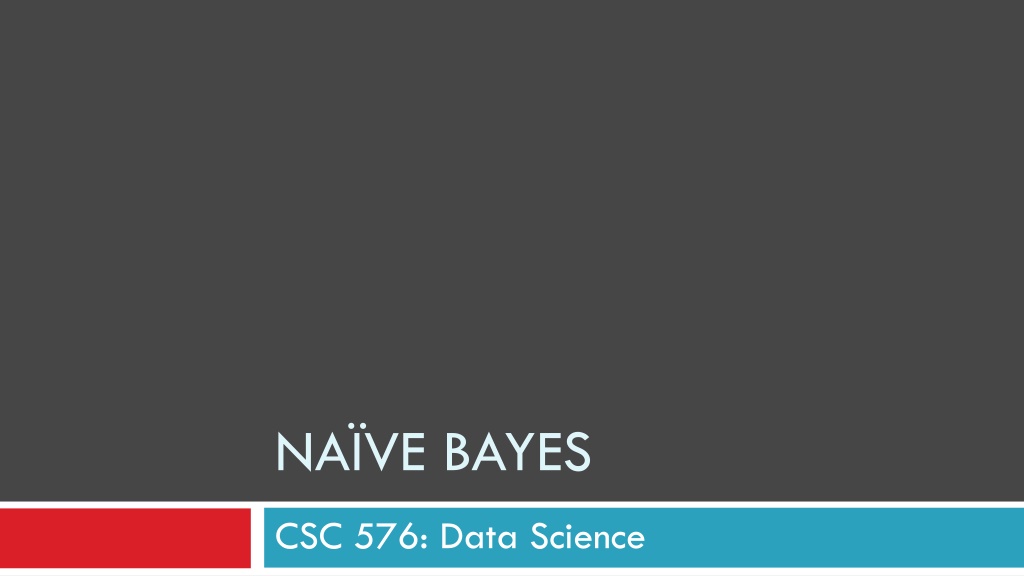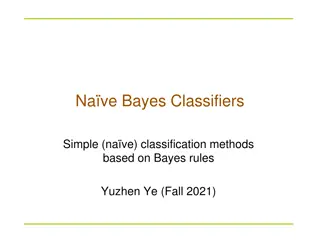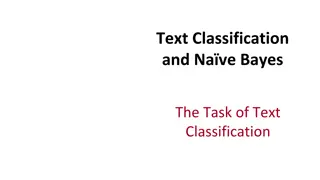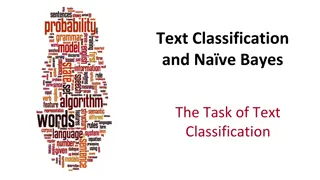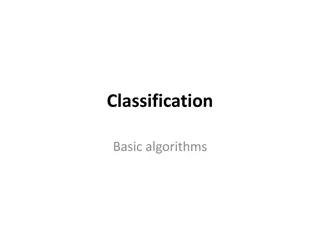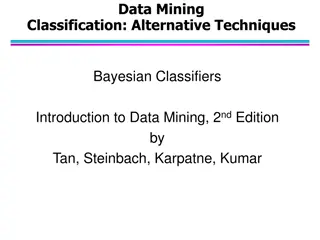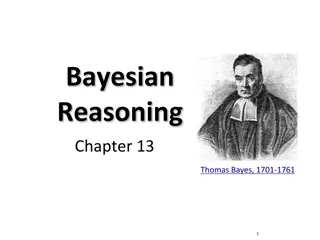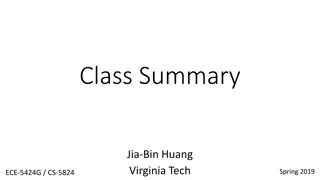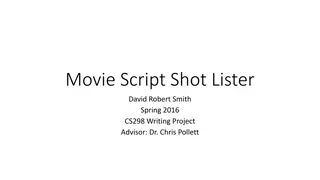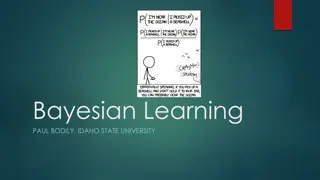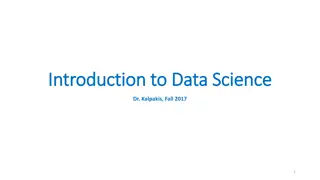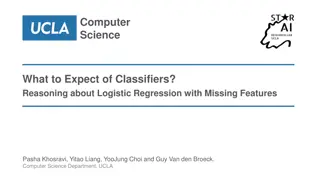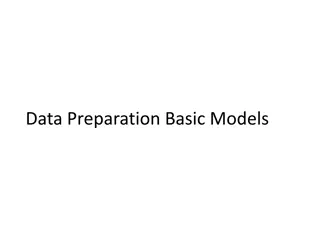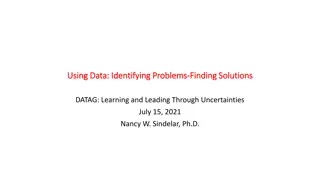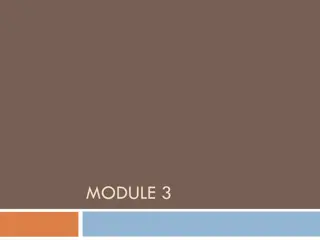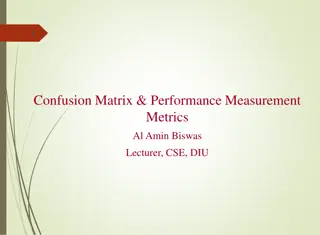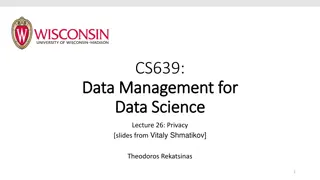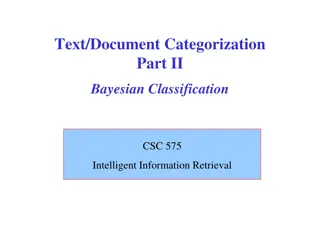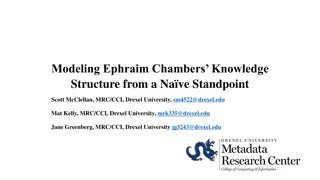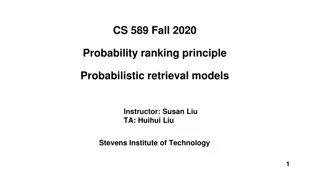Understanding Naive Bayes Classifier in Data Science
Naive Bayes classifier is a probabilistic framework used in data science for classification problems. It leverages Bayes' Theorem to model probabilistic relationships between attributes and class variables. The classifier is particularly useful in scenarios where the relationship between attributes and the class variable is non-deterministic, often due to noisy data, confounding factors, or missing relevant variables. By calculating conditional probabilities, Naive Bayes helps predict outcomes such as the risk of heart disease based on an individual's diet and workout frequency.
Download Presentation

Please find below an Image/Link to download the presentation.
The content on the website is provided AS IS for your information and personal use only. It may not be sold, licensed, or shared on other websites without obtaining consent from the author. Download presentation by click this link. If you encounter any issues during the download, it is possible that the publisher has removed the file from their server.
E N D
Presentation Transcript
NAVE BAYES CSC 576: Data Science
Today Probability Primer Na ve Bayes Bayes Rule Conditional Probabilities Probabilistic Models
Motivation In many datasets, relationship between attributes and a class variable is non-deterministic. Why? Noisy data Confounding and interaction of factors Relevant variables not included in the data Scenario: Risk of heart disease based on individual s diet and workout frequency
Scenario Risk of heart disease based on individual s diet and workout frequency Most people who work out and have a healthy diet don t get heart disease Yet, some healthy individuals still do: Smoking, alcohol abuse,
What were trying to do Model probabilistic relationships What is the probability that this person will get heart disease, given their diet and workout regimen? Output is most similar to Logistic Regression Will introduce na ve Bayes model A type of Bayesian classifier More advanced: Bayesian network
Bayes Classifier A probabilistic framework for solving classification problems Used in both na ve Bayes and Bayesian networks Based on Bayes Theorem:
Whats the probability that it rains today AND that Im carrying an umbrella? Terminology/Notation Primer X and Y (two different variables) Joint probability: P(X=x, Y=y) The probability that variable X takes on the value x and variable Y has the value y Conditional probability: P( Y=y | X=x ) Probability that variable Y has the value y, given that variable X takes on the value x Given that I m observed with an umbrella, what s the probability that it will rain today?
Terminology/Notation Primer P(X = x) Single Probability: X has the value x Joint Probability: X and Y Conditional Probability: Y given observation of X Relation of Joint and Conditional Probabilities: P(X,Y)=P(Y |X) P(X) P(X,Y) P(Y |X)
Terminology/Notation Primer P(X,Y)=P(Y |X) P(X) P(Y,X)=P(X |Y) P(Y) P(X,Y)=P(Y,X) P(X,Y)=P(Y |X) P(X)=P(X |Y) P(Y) P(Y | X)=P(X |Y) P(Y) Bayes Theorem: P(X)
Predicted Probability Example Scenario: A doctor knows that meningitis causes a stiff neck 50% of the time Prior probability of any patient having meningitis is 1/50,000 Prior probability of any patient having a stiff neck is 1/20 1. 2. 3. If a patient has a stiff neck, what s the probability that they have meningitis?
A doctor knows that meningitis causes a stiff neck 50% of the time Prior probability of any patient having meningitis is 1/50,000 Predicted Probability Example Prior probability of any patient having a stiff neck is 1/20 Apply Bayes Rule: If a patient has a stiff neck, what s the probability that they have meningitis? P(M |S) P(M |S)=P(S|M)P(M) P(S) Interested in: =0.5 150000 120 P(M |S)=P(S|M)P(M) =0.0002 P(S) Very low probability
How to Apply Bayes Theorem to Data Mining and Datasets? class categorical categorical continuous Tid Refund Marital Taxable Income Target class: Evade Evade Status 1 Yes Single 125K No Predictor variables: Refund, Status, Income 2 No Married 100K No 3 No Single 70K No 4 Yes Married 120K No What is probability of Evade given the values of Refund, Status, Income? 5 No Divorced 95K Yes 6 No Married 60K No 7 Yes Divorced 220K No 8 No Single 85K Yes 9 No Married 75K No P(E|R,S,I) 10 No Single 90K Yes 10 Above .5? Predict YES, else predict NO.
How to Apply Bayes Theorem to Data Mining and Datasets? class categorical categorical continuous Tid Refund Marital Taxable Income How to compute? Need test instance: What are values of R, S, I? Test instance is: Refund=Yes Status=Married Income=60K P(E|R,S,I) Evade Status 1 Yes Single 125K No 2 No Married 100K No 3 No Single 70K No 4 Yes Married 120K No 5 No Divorced 95K Yes 6 No Married 60K No 7 Yes Divorced 220K No 8 No Single 85K Yes 9 No Married 75K No Issue: we don t have any training example that these same three attributes values. 10 No Single 90K Yes 10
Nave Bayes Classifier Why called na ve? Assumes that attributes (predictor variables) are conditionally independent. No correlation Big assumption! What is conditionally independent? Variable X is conditionally independent of Y if the following holds: P(X |Y,Z)=P(X |Z)
Conditional Independence Assuming variables X and Y and conditionally independent, can derive: P(X,Y |Z)=P(X,Y,Z) given Z, what is the joint probability of X and Y? P(Z) =P(X,Y,Z) P(Y,Z) = P(X |Y,Z) P(Y |Z) = P(X |Z) P(Y |Z) P(Y,Z) P(Z)
Nave Bayes Classifier P(Y | X)=P(X |Y) P(Y) Before (simple Bayes rule): Single predictor variable X P(X) Now we have a bunch of predictor Variables: X1, X2, X3, , Xn P(Y |X1,X2,...,Xn) P(Y | X1,X2,...,Xn)=P(X1,X2,...,Xn|Y) P(Y) P(Y | X)=P(Y)Pi=1 dP(Xi|Y) P(X1,X2,...,Xn) P(X1,X2,...,Xn)
Nave Bayes Classifier P(Y | X)=P(Y)Pi=1 dP(Xi|Y) For binary problems: P(Y|X) > .5? Predict YES, else predict NO. P(X1,X2,...,Xn) Example: will compute P(E=Yes | Status, Income, Refund) and P(E=No | Status, Income, Refund) Find which one is greater (greater likelihood) Cannot compute / hard to compute: P(X1,X2,...,Xn) P(Refund=yes,Status=married,Income=120k) Can compute from training data: P(E =Yes) P(Refund= No|E =Yes) P(E = No) P(Y) Not a problem, since the two denominators will be the same. Need to see which numerator is greater. P(X1|Y) P(X3|Y)
Estimating Prior Probabilities for the Class target class categorical categorical continuous P(Y) Tid Refund Marital Taxable Income Evade Status P(Evade=yes) 1 Yes Single 125K No = 3/10 2 No Married 100K No 3 No Single 70K No P(Evade=no) 4 Yes Married 120K No 5 No Divorced 95K Yes =7/10 6 No Married 60K No 7 Yes Divorced 220K No 8 No Single 85K Yes 9 No Married 75K No 10 No Single 90K Yes 10
Estimating Conditional Probabilities for Categorical Attributes class categorical categorical continuous P(X1|Y) Tid Refund Marital Taxable Income Evade Status P(Refund=yes|Evade=no) 1 Yes Single 125K No = 3/7 2 No Married 100K No 3 No Single 70K No P(Status=married|Evade=yes) 4 Yes Married 120K No 5 No Divorced 95K =0/3 Yes 6 No Married 60K No Yikes! 7 Yes Divorced 220K No 8 No Single 85K Yes Will handle the 0% probability later 9 No Married 75K No 10 No Single 90K Yes 10
Estimating Conditional Probabilities for Continuous Attributes class categorical categorical continuous P(X1|Y) Tid Refund Marital Taxable Income Evade Status For continuous attributes: Discretize into bins Two-way split: (A <= v) or (A > v) 1 Yes Single 125K No 1. 2 No Married 100K No 3 No Single 70K No 2. 4 Yes Married 120K No 5 No Divorced 95K Yes 6 No Married 60K No 7 Yes Divorced 220K No 8 No Single 85K Yes 9 No Married 75K No 10 No Single 90K Yes 10
Given a Test Record: X =(Refund=No,Married,Income=75K) P(NO) = 7/10 P(YES) = 3/10 categorical categorical continuous Full Example class Tid Refund Marital Taxable Income P(Refund=YES|NO) = 3/7 P(Refund=NO|NO) = 4/7 P(Refund=YES|YES) = 0/3 P(Refund=NO|YES) = 3/3 Evade Status 1 Yes Single 125K No 2 No Married 100K No 3 No Single 70K No P(Status=SINGLE|NO) = 2/7 P(Status=DIVORSED|NO) = 1/7 P(Status=MARRIED|NO) = 4/7 P(Status=SINGLE|YES) = 2/3 P(Status=DIVORSED|YES) = 1/3 P(Status=MARRIED|YES) = 0/3 4 Yes Married 120K No 5 No Divorced 95K Yes 6 No Married 60K No 7 Yes Divorced 220K No 8 No Single 85K Yes For taxable income: P(Income=above 101K|NO) = 3/7 P(Income=below101K|NO) = 4/7 P(Income=above 101K|YES) = 0/3 P(Income=below 101K|YES) = 3/3 9 No Married 75K No 10 No Single 90K Yes 10
Given a Test Record: X =(Refund=No,Married,Income=75K) P(NO) = 7/10 P(YES) = 3/10 P(X|Class=No) = P(Refund=No|Class=No) P(Married| Class=No) P(Income=below 101K| Class=No) = 4/7 4/7 4/7 = 0.1866 P(Refund=YES|NO) = 3/7 P(Refund=NO|NO) = 4/7 P(Refund=YES|YES) = 0/3 P(Refund=NO|YES) = 3/3 P(Status=SINGLE|NO) = 2/7 P(Status=DIVORSED|NO) = 1/7 P(Status=MARRIED|NO) = 4/7 P(Status=SINGLE|YES) = 2/3 P(Status=DIVORSED|YES) = 1/3 P(Status=MARRIED|YES) = 0/3 P(X|Class=Yes) = P(Refund=No| Class=Yes) P(Married| Class=Yes) P(Income=below 101K| Class=Yes) = 1 0 1 = 0 Since P(X|No)P(No) > P(X|Yes)P(Yes) Therefore P(No|X) > P(Yes|X) => Class = No For taxable income: P(Income=above 101K|NO) = 3/7 P(Income=below101K|NO) = 4/7 P(Income=above 101K|YES) = 0/3 P(Income=below 101K|YES) = 3/3
Smoothing of Conditional Probabilities If one of the conditional probabilities is 0, then the entire product will be 0 Idea: Instead use very small non-zeros values, such as 0.00001 Original: P(xi| yj)=nc n n= # of training examples that have value yj nc= # of examples from class yj that take on value xi
Smoothing of Conditional Probabilities Idea: Instead use very small non-zeros values, such as 0.00001 Original: P(xi| yj)=nc n Laplace: P(xi| yj)=nc+1 n+C n = # of training examples that have value yj nc= # of examples from class yj that take on value xi C = # of classes
Given a Test Record: w/ Laplace Smoothing: X =(Refund=No,Married,Income=75K) P(NO) = 7/10 P(YES) = 3/10 P(X|Class=No) = P(Refund=No|Class=No) P(Married| Class=No) P(Income=below 101K| Class=No) = 5/9 5/9 5/9 = 0.1715 P(Refund=YES|NO) = 4/9 P(Refund=NO|NO) = 5/9 P(Refund=YES|YES) = 1/5 P(Refund=NO|YES) = 4/5 l P(Status=SINGLE|NO) = 3/9 P(Status=DIVORSED|NO) = 2/9 P(Status=MARRIED|NO) = 5/9 P(Status=SINGLE|YES) = 3/5 P(Status=DIVORSED|YES) = 2/5 P(Status=MARRIED|YES) = 1/5 P(X|Class=Yes) = P(Refund=No| Class=Yes) P(Married| Class=Yes) P(Income=below 101K| Class=Yes) = 4/5 1/5 4/5 = 0.128 l Is P(X|No)P(No) > P(X|Yes)P(Yes)? .1715 x 7/10 > .128 x 3/10 Therefore P(No|X) > P(Yes|X) => Class = No For taxable income: P(Income=above 101K|NO) = 4/9 P(Income=below101K|NO) = 5/9 P(Income=above 101K|YES) = 1/5 P(Income=below 101K|YES) = 4/5
Characteristics of Nave Bayes Classifiers Robust to isolated noise Noise is averaged out by estimating the conditional probabilities from data Handling missing values Simply ignore them when estimating the probabilities Robust to irrelevant attributes If Xiis an irrelevant attribute, then P(Xi|Y) becomes almost uniformly distributed P(Refund=Yes|YES)=0.5 P(Refund=Yes|NO)=0.5
Characteristics of Nave Bayes Classifiers Independence assumption may not hold for some attributes Correlated attributes can degrade performance of na ve Bayes But na ve Bayes (for such a simple model), still works surprisingly well even when there is some correlation between attributes
References Fundamentals of Machine Learning for Predictive Data Analytics, 1stEdition, Kelleher et al. Introduction to Data Mining, 1stedition, Tam et al. Data Mining and Business Analytics with R, 1stedition, Ledolter
